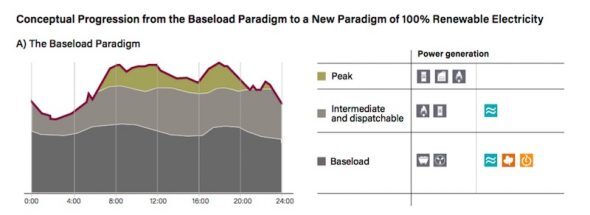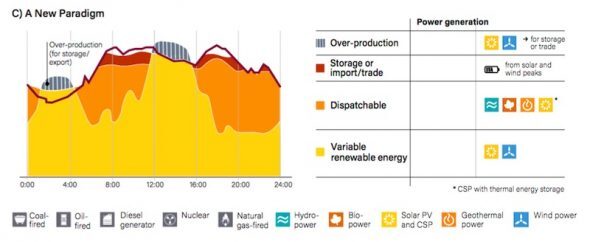Deconstructing baseload. It is the title of a chapter in a recent report from REN21, the global renewable energy agency, highlighting just how dramatic the energy transition will be as the cost of wind and solar continue to fall, and storage continues its rapid adoption.
Until just a few years ago, most of the world’s electricity grids looked something like the graph below: a whole lot of inflexible baseload (could be coal, nuclear or even hydro in some countries), backed up by intermediate and dispatchable generation and peaking plant (both mostly gas).

That’s now changing. In this “conceptual progression” from the Baseload Paradigm to a New Paradigm of 100% Renewable Electricity, REN21 outlines the key steps that are taking place and will take place.
In the early years of variable renewable generation, minor changes are made in the operation of country and state grids, including developing forecasting systems for renewable energy production, introducing improved control technology and operating procedures for efficient scheduling and dispatch.
Australia, like many other countries, is somewhere along this path – not so far in the still coal-dominated states like NSW and Queensland, but quite far in states like South Australia, already sourcing some 50 per cent its supply from wind and solar, and increasing rapidly.
And some of it is happening already, and you can read Tristan Edis here about how renewables trumped brown coal and gas in Australia over the 2017/18 summer.
(These graphs are a global average, so it is not entirely indicative of what will happen in Australia, given its excellent wind and solar resources and its geographic diversity. Nor does it take into account Australia’s own demand patterns – we’d likely see a demand trough around midday).
The later stages of the progression towards fully renewable power systems, REN21 says, will be marked by the integration of variable renewable power into the system by advanced forecasting, grid reinforcements, strengthened interconnections, and improved information.
This will come with controlled technologies, the widespread adoption of storage technologies, greater focus on energy efficiency and demand response, and the coupling of the heating and cooling and transport sectors.
In short, the latter spells the electrification of most things. It is interesting to note that Australia’s energy institutions, particularly the market operator, see the need for a similar portfolio of resources.
The graph above illustrates the need for storage to deal with over-production and to time-shift to meet peak demand periods, as well as the need for “dispatchable” resources.
Compare Solar & Battery Quotes

